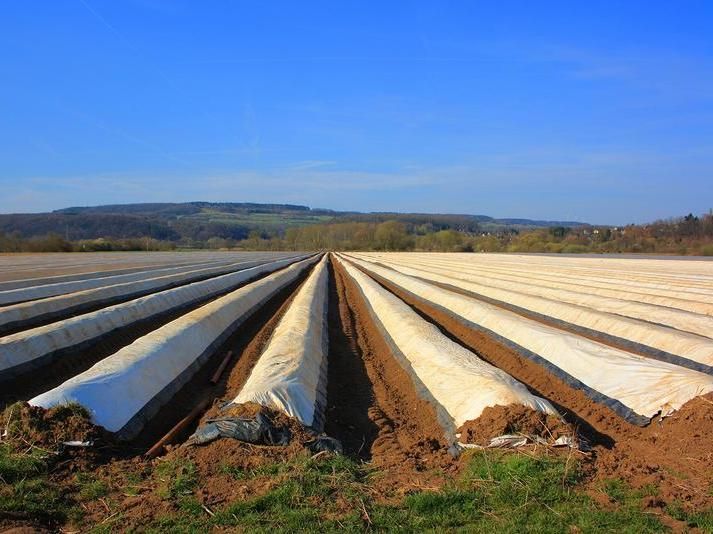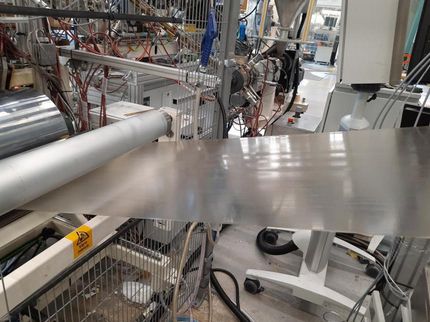Eliminating microplastics on farmland
Biodegradable paper replaces plastic films
Advertisement
In many countries, farmers and gardeners use mulch films to increase their crop yields. The films are often made of polyethylene and can be used to control weed growth, soil temperature and water consumption. Unfortunately the petroleum-based material is not biodegradable. Consequently, the film residues must be collected at the end of the season with considerable effort or they will pollute the fields. As part of the NewHyPe project, researchers at the Fraunhofer Institute for Silicate Research ISC are working with European partners to develop sustainable, biodegradable mulch papers with a protective hybrid coating.

Farmers use mulch films to control weed growth and soil temperature.
Asparagus, Pixabay
Plastic waste not only pollutes the oceans but also farmland. According to a study by the University of Bayreuth, large and small plastic particles can be detected in conventional farmland. Mulch films covering the soil of beds or farmlands in agriculture and gardening contribute to pollution. They are intended to prolong growing seasons and to reduce weeds, but also to reduce evaporation and to improve the water balance of the soil.
The films made of petroleum-based polyethylene (PE) must be collected after harvest-ing. This usually leaves residues. Consequently, PE residues remain in the soil for dec-ades and accumulate there as microorganisms are unable to break them down. PE fragments can have a physical impact on the soil and enter the food chain. While bio-degradable films made from polylactic acid are already available, they are very expen-sive. A team of researchers at the Fraunhofer ISC in Würzburg is working with research and industrial partners from Germany, Finland and Norway on the NewHyPe project to develop biodegradable, sustainable alternatives. An environmentally friendly substitute for the large films must be inexpensive and capable of being mass produced.
Biodegradable paper replaces plastic films
The project partners rely on cellulose-based paper for developing sustainable films. “One advantage of paper is that it can decompose very quickly without leaving any residue. But this process is currently too fast. The material does not last through a full farming season. Once it rains a few times, the material softens and the protection is no longer effective,”says Dr. Klaus Rose, researcher at Fraunhofer ISC. Consequently, a functional coating is needed to stabilize the paper and counteract rapid degradation. The protective hybrid coating is made of ORMOCER®. The material class of these inorganic-organic hybrid polymers was developed more than 30 years ago at Fraunhofer ISC. “The coating is made up of two different components, organic-polymer and inorganic-silicate, which usually are not compatible. But in combination, they provide chemical and mechanical stability while maintaining degradability,” the researcher explains. The substitute material should last for a farming season of about three to six months and should then decompose completely. First tests demonstrated that the coating of the paper increases its wet tenacity, making it more stable than its uncoated counterpart. Furthermore, a composting test showed that the coated material decomposes more slowly.
New hybrid mulch paper
Apart from the stabilizing functional coating, the project partners are working on a completely new hybrid mulch paper made of both functionalized cellulose with incorporated ORMOCER®s and functionalized nanocellulose, which is characterized by high inherent stability because of its very high length-to-thickness ratio. This involves bonding cellulose fibers with a hybrid polymer binder, crosslinking the individual fibers like an adhesive. The mesh density affects the stability. This binder system effectively acts as the coating. Consequently, the hybrid paper requires no additional coating. “The paper should be hydrophobicized, i.e. to be made water-repellent. Furthermore, it must be more tear resistant than normal paper. The mechanical stability as well as the UV resistance are important properties. It should be plowed under after the harvest,” the chemist explains. The optimal of the composite is the actual challenge. As soon as this has been fully developed, also the packaging industry could benefit from the new material as well: “Biodegradable paper instead of plastic films would constitute a significant contribution to environmental protection,” says Rose.
The mulch paper is to be produced using a roll-to-roll process. But this is not ready yet. Numerous tests are needed first, such as how the covering with paper films affects the growth of tomatoes and other crops.





















































